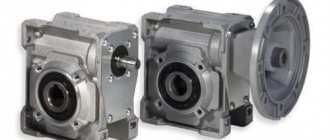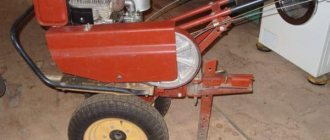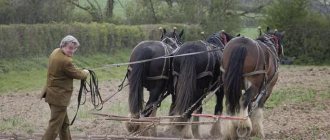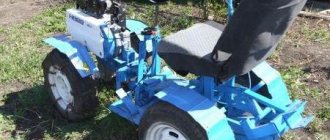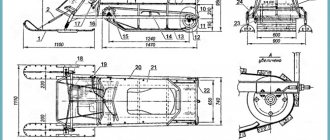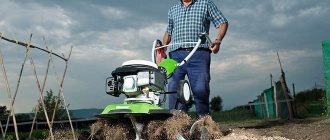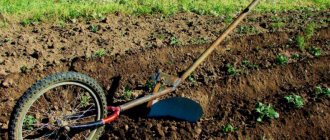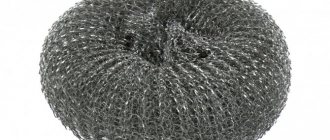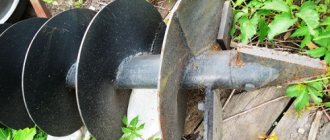For decades, the walk-behind tractor has served as a faithful assistant to the farmer in carrying out a whole range of agricultural work. This is a truly useful unit that allows you to mechanize work and increase productivity many times over. With the help of a walk-behind tractor, you can cultivate land plots, prepare hay and other feed for livestock, and even simply transport cargo. In some cases, there is a need to reduce the operating speed of this machine in order to increase the efficiency of certain operations.
Mechanism elements
Regardless of whether a purchased or homemade reduction gearbox will be used in a walk-behind tractor, you need to understand how the elements of the mechanism are located, how to maintain and repair them. Reduction gearboxes for walk-behind tractors can be of several types, each of which has its own advantages and disadvantages.
Scheme for connecting the speed reducer to the gearbox
Gear reducer
As a rule, it consists of one or two stages; The main elements are gears. This type is one of the most reliable mechanisms used in creepers. Used in the most powerful walk-behind tractors. Its advantages may include:
- durability;
- reliability;
- small dimensions;
- possibility of reverse.
Such creepers are not without their drawbacks, the main ones being maintainability and price. In case of breakdown, as a rule, they are replaced entirely, which requires significant financial costs. In addition, it is necessary to monitor the presence of lubricant, the absence of which can lead to rapid wear.
Worm gear
The main element is the worm gear. Allows you to reduce the dimensions of the walk-behind tractor and improve weight distribution due to the perpendicular arrangement of the drive shafts and wheels. Most often they are installed on light and low-power walk-behind tractors.
Main advantages:
- large gear ratio;
- small dimensions;
- light weight.
The main disadvantage of a worm gearbox is the lack of reverse. In addition, in the event of a breakdown, the stroke reducer is completely replaced.
Chain reducer
One of the most popular types of gearboxes among users. Most often they are made dismountable, which simplifies maintenance and diagnostics. The most common failure is a broken or stretched chain, shearing of sprocket teeth or drive shaft keys. All these breakdowns, as a rule, are quite easy to fix yourself by replacing the failed part.
The advantages of stroke reducers of this type include:
- simplicity;
- reliability;
- possibility of reverse;
- maintainability.
A separate article about a homemade chain gearbox for a walk-behind tractor.
Combined gearbox
Gearboxes of this type are characterized by the presence of different types of gears in one mechanism: gear-chain or worm-chain. The need for such stroke reducers is dictated by the fact that in gear and worm gearboxes the center distance between the drive and driven shafts is regulated by the size of the gear and directly depends on the engagement module and the number of teeth. In a chain drive, the distance between the shafts can be adjusted by removing or adding links.
When assembling the design of a walk-behind tractor, it is not always possible to place all the units in an ideal position, and the need for an intermediate transmission link arises. This function is successfully performed by a chain drive, which compensates for the distance from the gear or worm gear to the wheel or drive shaft.
What does the speed reducer consist of?
Depending on the type of reduction gearbox, a homemade creeper consists of the following main parts: input (high-speed) shaft, output (low-speed) shaft, worm and worm wheel, drive and driven gears or sprockets.
In this case, the driving sprockets and gears always have a larger number of teeth than the driven ones. Auxiliary elements can be various couplings, bearings, and keys. In gear and worm gearboxes there is always a housing, which cannot be said about chain gearboxes. They may either completely lack a case or cover only part of the mechanism.
Maybe you will be interested in making a mower for a walk-behind tractor or an adapter for a walk-behind tractor.
This is interesting: Do-it-yourself plow for a walk-behind tractor: drawings and manual
What to consider when choosing an engine for a walk-behind tractor
{amp}gt;First of all, the engine power and the volume of work to be done. The power selected is the same as on the old engine, or a little more. Light walk-behind tractors are units up to 5 hp; as a rule, they are purchased for plots of up to 20 acres. Equipment with power up to 7 hp. purchased for areas up to 1 hectare, and walk-behind tractors from 7 to 9 - 12 hp.
cultivate fields up to 4 hectares. It is clear that with increasing power, fuel consumption increases. But its consumption by a walk-behind tractor is insignificant and ranges from 0.9 to 2.5 l/hour. What you have to take into account is the weight: the more powerful the unit, the heavier it is. And yet, low-power walk-behind tractors, as a rule, experience very serious loads, often exceeding the norm, and work to the limit of their strength. That is why they fail faster and are considered less reliable than equipment with a powerful engine.
And finally, about the manufacturers of engines for walk-behind tractors. Domestic brands are not very popular among buyers due to their rather high cost and not very long service life, and some of them have been discontinued. Chinese models are more popular due to their low cost, reliability and versatility.
For processing plots of 10 - 15 acres several times a season, they are the best option. In addition, spare parts for this equipment are usually always available. For large areas and frequent work throughout the year, we recommend equipment from well-known world manufacturers, such as Robin-Subaru, Honda (Japan), and of course, the best are American engines from the Briggs{amp}amp;Stratton brand.
How to adjust the speed?
Sometimes it turns out that you want to change the speed of movement of your walk-behind tractor: increase it or, which happens quite rarely, decrease it.
To increase the speed of movement of walk-behind tractors, one of the two methods below is usually used:
- replacing wheels with larger diameter ones;
- replacing a pair of gears in the gearbox.
The usual wheel diameter of almost all walk-behind tractors is 570 mm. Most often, when replacing, tires are selected with a diameter that is approximately 1.25 times larger than this - 704 mm. Although the difference in size is relatively small (only 13.4 cm), the speed of movement increases significantly. Of course, if the design allows for larger tires, you can try to increase the speed gain.
A gear pair installed in a wheel reducer usually consists of two gears with the number of teeth 12 for the small one and 61 for the large one. You can change this indicator to 18 and 55, respectively (only from specialists at agricultural machinery service centers), then the gain in speed will be approximately 1.7 times. Do not try to carry out the operation of replacing gears yourself: it is very important to select not only high-quality parts with minimal errors, but also the appropriate pulley. The gearbox shaft locking plate also plays an important role.
Logically speaking, reducing the speed of movement of a walk-behind tractor can be achieved by performing diametrically opposite actions - reducing the diameter of the tires or the number of teeth on a gear pair.
A possible solution to increasing the speed is to adjust the gas switch: when the device turns on, move it from the first position to the second. To reduce the speed of movement, return to the starting position. Of course, to change the speed down, you don’t need special reducers - it’s enough not to switch to high gears.
Also possible solutions to the problem of increasing the speed of a walk-behind tractor are replacing the motor with a more powerful one and upgrading or installing a clutch system (in some outdated models it is not provided).
It can help to increase speed (especially on uneven terrain or heavy soils, where equipment often slips due to insufficient weight of the unit) and installing weights. They can also be made with your own hands from metal parts. Weighting structures are installed on the walk-behind tractor frame and wheels. For the frame you will need metal corners, from which a homemade removable structure is formed, that is, you can easily remove it if not needed. Additional ballast weights are attached to this removable additional frame. The wheels require steel discs and solid iron blanks with a hexagonal cross section. These parts are welded and inserted into the hubs. For reliable fixation, cotter pins are used, which are installed in specially prepared holes.
Of course, if you don’t have round steel elements at hand, you can replace them with almost any available material: reinforced concrete products or even flattened round plastic flasks with sand poured inside.
Don’t forget to maintain balance: the loads on the wheels must be equal in weight and evenly distributed across the frame, otherwise there will be a misalignment, which could cause your unit to fall on its side when performing turning maneuvers.
To speed up a walk-behind tractor with a trolley in bad weather conditions - snow, slush, soil soggy from heavy rains - you can install tracks (if the design allows). This method requires the installation of an additional wheel pair and the purchase of rubber tracks of a fairly large width. Limiters are attached to the inside of the track to securely fix the rubber and prevent it from jumping off the wheelset.
Installation of large wheels
A walk-behind tractor is a mini-tractor. designed for various agricultural operations. It is used to cultivate the land before planting vegetables, clean the garden, mow the grass, and even transport small loads. The higher the power, the faster the work will be done and the better the result. One of the most popular ways to increase the power of a walk-behind tractor is to install large wheels.
Standard wheels for motor-cultivating equipment have a size of 57 cm. You can increase the speed if you replace the standard equipment with tires whose diameter is at least 1.25 times larger. That is, such wheels should have a size of 70-71 cm. Even with such small tires, the speed of the walk-behind tractor increases significantly. If the wheel arches allow you to insert even larger tires, then you can try this, thereby increasing the speed several times.
When cultivating the soil with a walk-behind tractor, lugs are used. Such wheels are sold in special stores, and they can also be made at home, following the instructions provided on the Internet. The speed of movement of the unit depends on their size, which should be taken into account when using a walk-behind tractor.
Types of creepers for motorcycles
Stroke reducers for motorcycles can have different structures and operating principles. Consequently, any of these mechanisms has various parameters, advantages and imperfections.
Based on these indicators, reduction gearboxes available on the market for motorcycles are divided into several types.
- Gear reduction gearboxes – this equipment has a particularly robust design. The steel from which the gears are made is coated with specialized protective agents, which significantly increases stability and extends the period of use of gearboxes. Among the disadvantages of this type of device, it is necessary to focus on the high price.
- Worm reduction gearboxes - such devices are equipped with motorcycles with motors equipped with vertical shafts. The worm gear reducer for the unit is intended mainly for plowing previously cultivated soil. The use of a worm reduction gearbox on uncultivated land leads to its inevitable failure.
- Chain creepers - equipment of this type has a long service life and an affordable price. The shell of the device can be collapsible or non-demountable. The first sample is much more practical, since if a unit with a collapsible shell fails, it can in any case be repaired on its own.
- Combined (gear-chain) creepers - devices of this type are the most suitable solution for equipping tractors. They are characterized by a low price, have a long functional life and can withstand high loads.
Any reduction gearbox behaves differently under different conditions of use. You must not forget about this when choosing a specific device for motorcycles.
Inexpensive device with great functionality
A homemade machine is an economical and very useful motor unit. It is capable of performing all kinds of agricultural operations, thereby freeing a person from tedious physical labor. Even walk-behind rakes can be connected to it. In the video below you can see all the functionality of this miracle machine.
Such homemade products are applicable not only as an assistant in agricultural work. They are successfully used when cleaning the local area, and in winter - for clearing snow. If you make a high-quality homemade walk-behind tractor or motor-cultivator, then the operational parameters of the homemade product will be no worse than those of an expensive Chinese or domestic factory analogue.
Do it yourself
How to make a creeper for a walk-behind tractor with your own hands? The design of the mechanism is very similar to a gearbox. Including it in the operation of the walk-behind tractor redistributes part of the traction force to additional attachments. The work on manufacturing the device can be divided into several stages:
- Preparatory activities. At this stage, the body for the future mechanism is selected, metal pipes, bearings, gears, steel sheets and screws are prepared.
- Shafts are made. The main material is round rolled hardened steel. Using machines, the workpieces are turned to the exact size, and grooves are also made. Shafts transmit torque, and radial bearings hold them.
- Install chains and sprockets. It is better to purchase this material in a store.
- After assembling the creeper housing, it is tested. If any extraneous sounds or creaks occur, work is suspended and the violations are corrected.
Advice. You should only undertake the manufacture of home-made devices if you have experience and, when assembling, strictly adhere to the algorithm of necessary operations.
Best DIY Equipment
Homemade products with an engine from a walk-behind tractor (read do-it-yourself harrow for a walk-behind tractor) are also of some interest. Among them, the greatest interest is in the manufacture of a snowmobile. As a running gear, you can use a transport tape on which you need to attach snow hooks.
In addition, interesting are the options for manufacturing other various types of equipment from a walk-behind tractor:
- All-terrain vehicles. The design resembles a mini tractor, but has wheels of a higher diameter. This is necessary so that the unit can pass through the most difficult terrain.
- Mini tractors. We have already considered this design, which includes an additional part of the frame for a second pair of wheels, as well as steering wheels and the driver’s seat.
Required materials and tools
A speed reducer is a conventional reduction gearbox that increases torque by reducing engine speed. There are different types of such gearboxes; the gear type is most suitable for walk-behind tractors.
Speed reducer for walk-behind tractor
To assemble a reduction gear reducer you will need:
- measuring and drawing devices for creating a drawing;
- metal saw;
- drill with drills;
- bearings;
- pulley;
- steel sheet 3–4 mm thick (ST3 steel is suitable);
- finished housing (from the generator);
- bevel drive and ordinary driven gears;
- driven and rotor shafts.
You will need various bolts, nuts and washers for fastenings. In some cases, it is advisable to use a welding machine.
This is interesting: Motoblocks with a Honda engine: models, engine advantages
Assembly work
When assembling the unit, the elements are carefully installed in their places in the housing and scrolled. The case must be closed impenetrably - this will protect the elements from dirt and dust. Seals are mounted on the shafts. Lubricant is poured into the housing cavity. The homemade product is connected in the same way as a standard gearbox. To test it, start the motor and roll it along the ground. The components should rub together a little.
Requirements for personal safety when operating a reduction gearbox.
- When performing work, you must wear only durable special shoes.
- Before you start using the device, you must make sure that absolutely all fastening components are completely connected.
- It is necessary to lubricate all sprockets and chains with grease only before starting or after stopping the engine (it is recommended to perform this procedure at least once a year).
- This device belongs to the group of high-risk sources. It is prohibited to allow minors to operate it.
In addition, if the mechanism is stored for a short period of time, it must be cleaned of dirt and dust and wiped dry. If long-term storage of the equipment is planned, then not only cleaning is necessary, but also the application of special preservation oil to all surfaces and fastening joints.
See the following video about creepers for walk-behind tractors.
Assembly technology
Creating a homemade creeper, like any other complex mechanism, begins with drawing up a drawing. This will help determine the technical indicators - what torque is planned to be achieved, how many revolutions per minute should the rotor shaft make, etc. At this stage, the main input parameter from which to build is the standard power of the walk-behind tractor.
At the preliminary stage, it is necessary to make or select a housing for the gearbox, since all moving elements of the creeper for the walk-behind tractor must be closed.
Making a creeper with your own hands
After that:
Do-it-yourself creeper for a walk-behind tractor - drawing
- In accordance with the diameter of the gearbox, it is necessary to cut out the bearing shells from metal, which will be mounted on the drive shaft. The flange must be located on the reverse side of the gearbox, opposite the bearings.
- Screw the flange to the generator housing.
- Place the drive gear on the rotor shaft and the driven gear on the driven shaft. Connect them to each other.
- Install the belt drive pulley onto the driven shaft using spring washers and nuts.
- Make sure that all parts of the assembled creeper are connected to the rotary generator shaft.
- Place it in the case.
- Check the mechanism in action.
Other design options
Speed reducer for walk-behind tractor with worm gear
This gear reducer for a walk-behind tractor is highly reliable. Unlike some other solutions, it has the ability to reverse, that is, the device will be able to move in reverse.
This device is suitable for a walk-behind tractor of medium or high power (from 15 hp). For less powerful units, it is optimal to use a worm gearbox, which has a large gear ratio and, accordingly, provides a greater increase in torque. But the worm gear will not allow the walk-behind tractor to move in reverse, and making it yourself is much more difficult. Finished blocks are non-repairable.
A chain reducer is used less frequently. Sometimes combined gear-chain and worm-chain modifications are used.
The fastest models
First, let's find out which walk-behind tractors are considered the fastest? Do domestic manufacturers have advantages or does the palm unconditionally belong to foreign competitors?
By the way, it is quite difficult to determine the undisputed winner in terms of maximum speed, because not only are there a great many models of walk-behind tractors from various manufacturers today, but it is also possible to independently modernize this multifunctional agricultural unit.
Motoblocks MTZ-05, MTZ-12 have 4 speeds when moving forward and 2 in reverse. The minimum speeds correspond to the first gear; when switching to the next gear, it increases. For the above models, the minimum speed when moving forward is 2.15 km/h, when moving in reverse – 2.5 km/h; the maximum when driving forward is 9.6 km/h, when driving backwards – 4.46 km/h.
The Mobil-K G85 D CH395 / Grillo walk-behind tractor has a maximum forward speed of 11 km/h, and a reverse speed of 3 km/h. At the same time, the gearbox provides the ability to switch between three forward and two rear speeds. Don't forget that all these figures are true for unimproved models.
“Mobil-K Ghepard CH395” is a Russian-made walk-behind tractor, has a 4+1 gearbox, and can accelerate to 12 km/h.
The Ukrainian motor-block "Motor Sich MB-6D" can reach a speed of 16 km/h, the gearbox is six-speed (4+2).
The Centaur MB 1081D unit is Russian, but is produced in Chinese factories. It is considered the fastest walk-behind tractor in the heavy class. Its maximum speed is as much as 25 km/h! Refers to diesel walk-behind tractors, unlike the models listed above - they run on gasoline.
Features of operation
General device of the creeper
After the creeper has been installed on the walk-behind tractor, it is necessary to check its operation at least once every six months, periodically changing the oil in the bearings, lubricating the chains, pulley and sprockets. If the device is rarely used and is mainly stored, then it should be provided with anti-corrosion treatment and high-quality preservation using appropriate oil.
Before starting work, you need to make sure that the gearbox housing is closed, all elements are in good condition and securely fastened together. During work, only shoes with thick leather uppers should be used.
The speed reducer for a walk-behind tractor can only be wiped and lubricated when it is turned off and cooled down.
This device belongs to the category of sources of increased danger. Minors should not be allowed to work with him.
Related video: DIY creeper
How to make a mower from a walk-behind tractor, choosing attachments
In the summer, one of the important tasks for farmers and land owners is mowing the grass.
If you do this manually, it takes a lot of time and effort. Therefore, mounting mowers on walk-behind tractors is an almost indispensable tool. It makes work easier and significantly reduces time costs. For example, mowers for walk-behind tractors will help you quickly prepare mowing for cattle.
When choosing a mower for a walk-behind tractor, you need to evaluate the landscape of the area where it will be used. In each territory, crops grow that differ in height, density and composition of herbs. Therefore, two types of mowers were developed
- disk (rotary);
- finger (segmental).
A mounted disc or rotary mower is used for mowing vegetation up to 1 cm in diameter, dense grasses and low shrubs. This model is used on flat terrain with slopes of no more than 15-20°, with a side slope of no more than 8°. Grass cut by a rotary mower is laid in rows.
The disadvantage of such devices is the high probability of injury, and when working with them it is necessary to avoid stones, as this will lead to breakage. The advantage of a mounted mower is its simple design, which results in a low level of breakdowns (except for the possibility of stones falling into it). Important! When working with the mower, you must follow safety rules. In particular, every two hours of operation of the unit you should check the fastening of the nuts and the tension of the belt, and all maintenance operations should be carried out with the walk-behind tractor engine turned off.
Before starting work, it is also worth checking the strength of all connections, and during the work itself you should not be in front of the cutting apparatus.
Segment mowers
By design, the segment mower has cutting blades that move progressively under the influence of the engine shaft. They are not afraid of thick branches and stones. The belt drive is hidden in a special casing. The quick-hitch mechanism allows you to quickly dismantle and reinstall the mower on the walk-behind tractor.
Today, walk-behind tractors are perhaps the most common type of mini-equipment for agricultural purposes. It happens that users of some models are no longer satisfied with the speed and performance of the unit.
Additional accessories
- Installation of a rake on a walk-behind tractor for collecting debris, leaves, and hay. Such a simple device will speed up autumn field work and allow you to clear large areas of debris in a matter of minutes. To make a rake you will need: several meters of reinforcement with a cross section of 8-12 mm and a strip of sheet metal. The reinforcement is cut into pieces 10 cm long and welded to the plate in several rows with an interval of 3-5 cm. To increase maneuverability, the rake can be equipped with roller wheels.
- A trailer and cart will help transport large loads. The cart can be made from scrap materials - channel and old car wheels, metal profiles and boards. The clutch is made standard for both tractors and cars.
- If desired, you can make a potato digger, hiller and harrows, which will not be inferior in quality to purchased ones.
Plows for walk-behind tractors
- The easiest to use is the single-hull one, also known as the Zykov plow.
- Reversible plow for walk-behind tractor: rotary or reversible. The upper part has a curved feather, which turns the soil over during plowing. A universal device that easily copes with plowing heavy soils. Quickly copes with the treatment of areas with clay and marshy soil.
- The rotary plow for a walk-behind tractor has a complex design. Depending on the number of ploughshares, there are two-body and three-body models. Active plowshares dump soil in one direction only, while passive plowshares level the beds and lift them. Tilling the soil with such a plow has a number of advantages: the soil is maximally saturated with oxygen; tire wear and fuel consumption are reduced; after processing there are no large clods of earth left.
- A rotary plow for a walk-behind tractor provides unlimited possibilities. During operation, the axis rotates, and with it the soil layers. It easily plows even very hard soil at a depth of about 30 centimeters. There are paddle, drum, shovel and auger plows. Devices of the first type are equipped with a rigid pusher and can consist of a spring plate or be combined. Units of the second type are equipped with a disk with blades that rotate during operation. A plow with a disc blade for a walk-behind tractor is suitable for work in early spring; it copes well with wet soil.
Hiller
To make it, we will need a pair of ordinary metal pan lids (enameled ones will not work in this case). Their diameter should be about 500 mm. Next, we sharpen the edges of the covers on a grinding machine so that they fit better into the soil.
Disc hillers need to be attached to a homemade cart with wheels. They are made from ordinary bushings and pipes welded together.
Attachments to walk-behind tractors and walk-behind cultivators, homemade products of which can be easily made independently, come in a wide variety of types:
- Weeding equipment.
- Potato diggers and potato planters.
- Snow blowers, etc.
How much oil to pour into the walk-behind tractor gearbox
When operating the walk-behind tractor, it is necessary to maintain a constant oil level in the gearbox. If this simple rule is not followed, lubricant residues may boil and jam the parts. Only high-quality oil is poured. Even with constant maintenance of the level, breakdowns occur. During chain transmission, the chain breaks or is pulled out. If traces of oil appear on the outside, this is a sign of leaking seals. Worn parts require replacement with similar ones. It is better to purchase them from a reputable manufacturer.
The gearbox ensures uninterrupted operation of the walk-behind tractor, extends its service life and increases the efficiency of use of the unit. A good helper in this matter is to lubricate its parts. Transmission oil is poured in for lubrication. Its possible brand is ZIC 10W40, Super T-3. The oil level is determined in this way:
- you need to take a wire approximately 70 cm long instead of a probe and bend it into an arc;
- insert into the filling hole until it stops;
- pull the homemade dipstick back;
- the wire should be oiled to a length of about 30 cm.
This level is considered to be the norm. If there is little oil, you need to add it to the norm. In a purchased gearbox, the level must be indicated in the instructions. A Chinese walk-behind tractor can be sold without oil.
Modifications in the brait-135 line
The catalog of the official website of the Bright company currently offers 11 modifications of Bright-135 walk-behind tractors, two of them are diesel. Let's talk about them first.
- Brait-135DEA (diesel) – this option is equipped with a 4-stroke, single-cylinder diesel engine BR-178FE, vertical air-cooled, with direct injection, with electric start (battery included). The power of this engine is 7 horsepower, its working volume is 296 cm3. Cylinder diameter x stroke – 78 x 62. Output shaft: 25 (for splines). Milling cutter shaft: hexagon D=32. Engine oil capacity – 1.1 liters. Gearbox oil volume: 2.3 l. Fuel tank capacity – 3.5 liters. Walk-behind tractor weight: 138 kilograms.
- Brait-135DEB (diesel) – equipped with a 4-stroke, single-cylinder BR-186FAE diesel engine, vertical air-cooled, with direct injection, with electric start (battery included). The power of this engine is 10 horsepower, its working volume is 418 cm3. Cylinder diameter x stroke – 86 x 72. Output shaft: 25 (for splines). Milling cutter shaft: hexagon D=32. Fuel tank capacity – 5.5 liters. Engine oil volume – 1.65 l. Gearbox oil volume: 2 l. Walk-behind tractor weight: 148 kilograms.
Gasoline:
- Brait-135GA – with a 4-stroke, single-cylinder BR-170F engine. The working volume of this engine is 212 cm3, its power is 7 horsepower. The starter is manual. Output shaft: 20 (keyed). Milling cutter shaft: hexagon S32. Oil capacity 1.1 l. Gearbox oil volume – 2.0 l. The volume of the fuel tank is 3.6 liters. Walk-behind tractor weight: 136 kilograms.
“Behind the wheel” of a light petrol walk-behind tractor Brait-135GA.
- Brait-135GB – equipped with a 4-stroke, single-cylinder BR-177F engine with a working volume of 270 cm3, 9 horsepower, with a manual starter. The weight of the walk-behind tractor in this modification is 143 kilograms. The volume of the fuel tank is 6 liters. Oil capacity: 1.1 l. Gearbox oil volume – 2.3 l. The cutter shaft is a hexagon D=32.
- Brait-135GBD is a walk-behind tractor with technical characteristics similar to the Brait-135GB model, but also equipped with a differential. The weight of this walk-behind tractor is 150 kilograms.
- Brait-135GBE – equipped with a 4-stroke, single-cylinder BR-177FD engine. Its working volume is 270 cm3, power – 9 horsepower. Starter with electric start (battery included). Output shaft: 25 (keyed). Milling cutter shaft: hexagon S32. The volume of the fuel tank is 6 liters. Engine oil volume: 1.1 l. Gearbox oil volume: 2 liters exactly. The weight of such a walk-behind tractor is 156 kg.
- Brait-135GC - with a 4-stroke, single-cylinder engine with a power of 13 horsepower and a displacement of 389 cm3. The starter in this modification is manual. The volume of the fuel tank is 6.5 liters. The weight of the walk-behind tractor is 150 kilograms. Milling cutter shaft: hexagon S32.
- Brait-135GCE - also with a 4-stroke, single-cylinder engine with a power of 13 horsepower and a displacement of 389 cm3. But with electric start (battery included). The volume of the fuel tank is 6.5 liters. The weight of the equipment in this modification is 163 kilograms.
- Brait-135GD - equipped with a 15-horsepower 4-stroke, single-cylinder engine with a working volume of 420 cm3. The starter is manual. The volume of the fuel tank is 6.5 liters. The weight of the walk-behind tractor is 148 kilograms.
- Brait-135GDE – also with a 4-stroke, single-cylinder gasoline engine with a displacement of 420 cm3 and a power of 15 horsepower. But equipped with electric start (battery included). The weight of the walk-behind tractor in this modification is 163 kilograms.
- Brait-135GDD is a walk-behind tractor, similar in its technical characteristics to the Brait-135GD modification, but equipped with a differential. The weight of the walk-behind tractor in this version is 153 kilograms.
Gear
A gear converter with a differential is used in heavy-duty walk-behind tractors. It is well suited to engines with a vertical crankshaft. The gearbox produces little noise during operation and has high performance. It is capable of functioning in straight and angular patterns.
On heavy units, the gear converter is often equipped with a gearbox. This transmission allows the walk-behind tractor to move in reverse. Reverse occurs during reverse rotation of the gears in the housing. This is achieved by changing the position of the lever outside the housing.
Gear reducer is the best choice for heavy agricultural machinery. An engine equipped with this mechanism runs longer than with a worm version.
Worm
Worm gearboxes are widely used in mini-tractors and walk-behind tractors. This model has gained popularity due to its long period of trouble-free operation and high reliability. The worm-type device has a reverse, allowing the unit to move in reverse.
The screw can have a four-start thread or a two-start thread. It matches the thread on the gear. The teeth on high-quality parts are made of anti-friction steel. The efficiency of the device is high. Its advantages:
- the gearbox allows you to extend the service life of the engine;
- creates little noise during operation;
- The device consists of only 2 parts;
- has a large gear ratio;
- has a smooth ride;
- high self-braking effect.
All positive qualities appear with precise assembly and adjustment of the mechanism.
Chain
A chain device must have a chain in its design. Sometimes it occurs not just one, but in several pieces. The gear chain is put on the sprockets and ensures their rotation. The device is easy to use, has a reverse function and a high degree of reliability.
Reliability of operation is ensured by the quality of the metal of the sprockets and the strength of the chain. When making your own gearbox, you should use motorcycle sprockets; they are much stronger than bicycle sprockets. The design of the product is simple and reliable, it has a reverse function.
